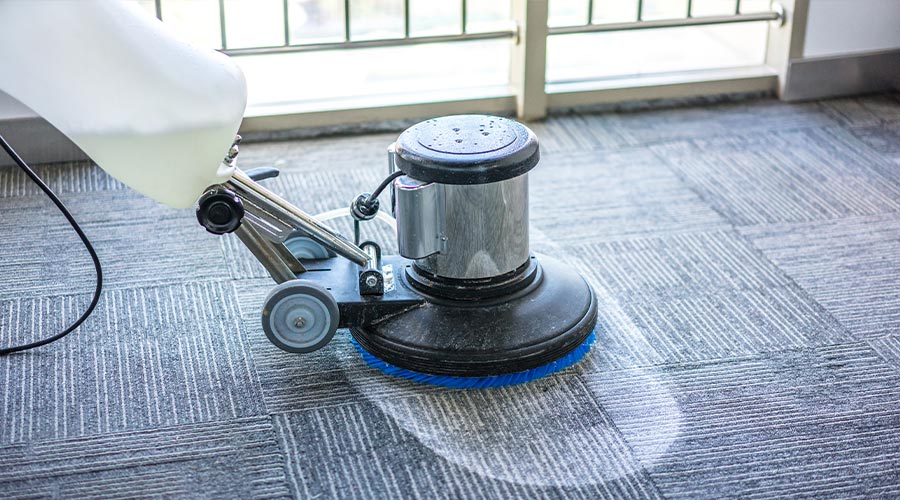
While the more-is-better mindset was prevalent before the pandemic, facilities today are scaling back when it comes to carpet care. That means fewer chemicals, less water and less hot-water extractions. This less-is-more approach appears to be driven by several factors, including more emphasis on sustainable practices and the need to improve productivity.
“Low-moisture processes like encapsulation and dry compound cleaning have really started to take hold, because they increase your productivity and decrease your dry times,” says Dane Gregory, an industry trainer and consultant who specializes in floor and carpet care. “Custodians are able to move through the facility 5 to 7 times faster than they would with a deep cleaning.”
According to Gregory, the goal is to postpone deep cleaning as long as possible — not because it doesn’t work, but because it’s a slower process.
“If your employees are working at a faster pace, you can use that budget savings somewhere else, like high dusting or other tasks you normally don’t get a chance to do,” he says.
Chemical developments have also improved the encapsulation process. Additives such as hydrogen peroxide answer the call for eco-friendly products and mitigate staining. Gregory is also seeing more double-strength solutions that require less chemical usage and produce less residue. That’s another win for sustainable carpet cleaning.
Meanwhile, Franke has noticed a shift to cold-water extraction in recent years due to new chemistries that work as well — if not better — in cold water as in hot water.
“With cold-water extraction, you’re using less energy because you don’t have to produce hot water. It’s all part of that environmentally friendly message,” he notes.
In addition to chemical advancements, the industry is also benefiting from better equipment and technologies that improve efficiency and cleaning outcomes. For instance, rather than vacuuming in one direction, new extraction tools vacuum both forward and backward. Vacuuming technology has also advanced, allowing portable extractors to pick up over longer distances.
“Typically, the hose on extractors was between 25 and 50 feet, so you would work in a circle around the portable, and then move it,” Gregory explains. “Now, with better vacuuming technology, you can run 150 feet of hose, so you can clean in a 300-foot circle without having to reposition the machine.”
Mats Matter
Effective matting was and still is the best way to capture or control dirt and soil before it enters the facility and finds its way into carpets. According to Hulin, a proper matting system requires a combination of different mats:
-
Scrapper grid/mat. This should be placed outside at the entry to capture heavy debris, dirt, and soil.
-
Grass or fiber mat. This mat is placed in a vestibule at the entrance to absorb moisture, dirt, and soil.
-
Fiber mat. This mat is placed in the lobby after patrons pass through the vestibule to trap the remaining dirt and soil.
“It’s worth noting that the mats themselves are effective, but are even more effective when combined with length,” says Hulin.
Recommendations for the appropriate length of matting have remained the same over the years. Experts advise using enough matting for “three good steps,” which requires at least 10 to 12 feet of matting, according to Franke.
Ideally, facilities need 25 feet of matting to remove 100 percent of the soil and dirt entering the building; however, as Gregory points out, that amount of matting is neither practical nor aesthetically pleasing.
“No one wants to do that inside their building, so carpet manufacturers have found a way to incorporate walk-off carpets as part of the overall carpet design,” he says. “These walk-off mats can be Velcroed to the carpet so that they can be replaced or cleaned.”
Other recent trends give a nod to sustainability — such as matting made of recycled content — and those with improved functionality. Gregory shares that scraper mats have become more aggressive with more fibers that come into contact with shoes, thereby cleaning them more thoroughly.
Efficiency Pays
As Gregory points out, facility budgets aren’t getting bigger, which is why cleaning departments are constantly looking for ways to boost productivity — whether they’re cleaning hard flooring or carpets. Fortunately, in the wake of the pandemic, facilities are paying more attention to the importance of cleanliness in their buildings, including a preventative carpet care program.
“It’s always about labor costs, so people are interested in what we can do to minimize that by speeding up the productivity process,” says Gregory. “They’re understanding there are more ways to clean carpets than just the traditional way they’re familiar with, which is deep cleaning.”
Facilities are also realizing the value of equipping custodians with the necessary carpet cleaning tools.
“It comes down to buying the right equipment for the job,” says Franke. “You can’t give someone a 12-inch vacuum cleaner to clean hallways and conference rooms in a hotel. At the end of the day, the square footage never shrinks, so you must invest in the right equipment to get the job done.”
Kassandra Kania is based out of Charlotte, North Carolina, and is a frequent contributor to Facility Cleaning Decisions.
Updating Carpet Care Strategies for Current Cleaning Expectations

 Celebrating BSCAI's 60th Anniversary eBook
Celebrating BSCAI's 60th Anniversary eBook The Down and Dirty on Cleaning in Virus Season
The Down and Dirty on Cleaning in Virus Season How Surfactant Use is Expanding in Commercial Cleaning
How Surfactant Use is Expanding in Commercial Cleaning